German cuisine
culinary traditions of Germany
German cuisine offers many different regional cooking styles and culinary specialities. Both traditional food and drinks and new creations and variations are appreciated.
Since the 1950s, foreign cuisines have increasingly found their way into Germany and have mixed with local dishes. There is hardly a place with gastronomy where Turkish, Greek, Italian or other international restaurants are not represented. Global fast food chains are also widespread, and the trend towards slow food is also gaining ground. Since the beginning of the 21st century, there has also been a trend towards lighter cuisine. Crossover cuisine, or fusion food, is becoming fashionable and vegetarian or vegan dishes are also making their way onto menus.
According to the Michelin Guide and other gastronomy guides, top gastronomy in Germany has reached a high global status. In the 2015 edition, 282 restaurants nationwide were awarded stars, the third most after Japan and France.
| Cuisines of Europe British & Irish • French • German (Bavarian • Franconian) Georgian • Greek • Italian • Nordic (Finnish) • Portuguese • Russian • Spanish |
Understand
German cuisine has traditionally been affected to a large degree by the (seasonal) availability of certain ingredients and the climate. As Germany has colder winters than the Mediterranean countries, it historically had a stronger focus on simple and hearty meat dishes, particularly pork. Like its neighbours Poland, Austria and the Czech Republic, with which it shares quite a bit in culinary terms, Germany was and is a big producer and consumer of all kinds of sausages that are fried, smoked, dried, steamed, cooked or eaten raw. A particular German treat is breakfast (Frühstück), which can last hours on a lazy Sunday forenoon and usually includes jams, rolls, coffee and hot chocolate but also savoury treats like sausage. German cuisine also has a lot in common with that of the French region of Alsace and the German-speaking part of Switzerland.
German cuisine has a lot of regional variation not least because of the historically fractured nature of its politics, as Germany was not unified until the 19th century. Despite 40 years of East-West partition which left their mark, sometimes due to a shortage in certain ingredients during the communist period which led to surrogate creations, most German cultural cleavages divide the country into North and South. So you will not experience a great culinary difference between Schleswig-Holstein (West) and Mecklenburg (East) as both belong to the northern region, while the cuisine of Thuringia (East) is not much different from the Franconian one (West), both being variants of the central-to-southern cooking tradition. That said, foreign influence tends to vary quite a bit. While even relatively minor towns tend to have people of Turkish descent (and their cuisine) in the West, the largest immigrant group in the East is Vietnamese people and they make up a rather smaller portion of the overall population even in large cities. Similarly, American and to a smaller extent French and British influence were much stronger in the West while the East had some Soviet and Hungarian influence but also tried to copy "Western" food (West German TV was available to most East German households throughout partition) while avoiding issues of resource scarcity and intellectual property.
Saltwater fish is more commonly eaten in the North, but preserved fish of various kinds was already common far from the sea during the Middle Ages, as old documents and archaeology show. The most commonly eaten freshwater fish are carp (Karpfen) trout (Forelle) and pike (Hecht), the latter usually a side-product of carp farming. In certain regions there are large areas covered by artificial bodies of water to raise fish, particularly carp. In historically Catholic regions it is still common to eat fish on Fridays and during Lent, which also explains the historic association between carp and cloisters. A vegetable that is still a seasonal craze in most of Germany is asparagus (Spargel) which can fetch prices of €10 per kilo. White asparagus is usually eaten with sauce hollandaise, potatoes and ham. Green asparagus is also available but much less popular. Restaurants usually add an extra page with asparagus dishes to their menu during asparagus season.
German cuisine has also been exported to other parts of the world such as Australia and the United States by the German diaspora, and many localised versions of German dishes can be found in the cuisines of those countries. For instance, the schnitzel, albeit one made from beef or chicken rather than pork, has been widely adopted as a staple of Australian cuisine, while German sausages gave rise to the American hot dog. And the word "Hamburger" for perhaps the most iconic element of fast food references the harbour through which millions of German emigrants passed in bygone days. The Midwest and Pennsylvania in the United States, and the Australian state of South Australia are some areas where German influence is particularly pronounced.
.jpg.webp)
Berlin, the cosmopolitan capital with a lot of immigrants from nearly everywhere, has a wide selection of international cuisines as well as several dishes which originated in Berlin or were "perfected" there, but just as the German economy is rather decentralized with many a "hidden champion" in small towns you might not have heard of, the German culinary scene is not focused on a single urban centre.
Kosher and halal
While Ashkenazi cuisine in particular shows some overlap with central European cuisine ("Ashkenaz" means "Rhineland") genuinely kosher restaurants are limited to a handful in big cities. Sometimes a synagogue will have an on-site kosher cafeteria, but its offerings may be limited and it may not always be open to those that don't attend services. Kosher ingredients - even "normal" products that one would expect to be kosher by default carrying a kosher label - are rare and virtually only sold in specialist supermarkets. Due to the presence of a sizable ex-Soviet Jewish community, some stores aimed at Russian immigrants offer kosher ingredients.
"Halal" (sometimes spelled "helal" as in Turkish) food is usually available at Muslim-owned businesses and more than half of all Döner stalls proudly display their halal certificate. Vegan and vegetarian products (e.g. gelatine-free gummy bears) are often marked as "halal" despite that being superfluous as vegan non-alcoholic foodstuff is halal by default. Turkish or Arabic supermarkets often carry mostly or all halal product lineups.
Regional cuisines
In all regions of Germany there is still native cuisine using local produce, rooted in traditional customs. These dishes are often easier to find in rural areas than in the city. Often the menus of several restaurants have to be compared to discover the local specialities, but the effort is worth it. Germany tastes different everywhere, a wonderful variety of flavours. Further information can be found in the relevant region and city articles.
Further articles on the subject:
Records
- The municipality of Aufseß is known for its brewery density and received an entry in the Guinness Book of Records in 2001. The 1,317 inhabitants share 4 breweries, and, with 330 inhabitants per brewery, the town has the highest brewery density in the world.
- Baiersbronn is the only German community with 8 restaurants with stars from the Michelin Guide and also the only one with two 3-star restaurants.
- The strongest beer in the world (57.5% alcohol) is brewed by the small brewery Oberasbacher Schorschbräu near Gunzenhausen. The bock beer is cooled down and the resulting ice crystals are separated, leaving beer with a higher alcohol content.
- The highest restaurant in Germany is on the Zugspitze at 2,600 m (8,500 ft) above sea level.
- The Berggasthof Ahornkaser near Berchtesgaden is the highest mountain inn in Germany that can be reached by car at over 1,520 m (4,990 ft) above sea level.
- The döner kebab sandwich is Germany's most popular street food dish (as of 2024, it stole the title from currywurst), with around 18,000 shops in the country that together sell millions of kebabs a day.
Meat dishes
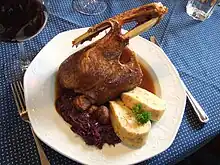
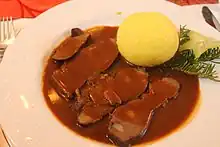
Schnitzel
In all German regions, pork schnitzel with French fries or potato salad is on the menu. As you'll find it on the menu everywhere in Germany, it is well suited to determine the price level of an individual restaurant or region. The prices vary between €5 and €20. Some of the most well-known variants are enumerated below. The variety of schnitzel variations in Germany is, however, indescribable. One can find a new taste experience each day; many menus offer surprises.
- A Wiener Schnitzel is found on the menu less often. It is prepared from veal and is, correspondingly, more expensive. Usually, the cheaper Schnitzel Wiener Art made of pork is offered.
- Jägerschnitzel (Hunter's schnitzel) is usually a roasted pork cutlet, more rarely made from veal with a mushroom-tomato or mushroom-cream sauce. In some areas it is breaded, in others it is not. The latter is called a natural schnitzel. A further variant, which originated in East Germany and can still be found there, is breaded centimetre thick slices of Jagdwurst or beer ham and served with a sauce of tomatoes with onions. Potatoes, potato salad, mashed potatoes, French fries, croquettes or noodles are served as a side dish.
- Berliner Schnitzel - not a real schnitzel, but breaded cow's udder
- Cordon bleu is a breaded schnitzel filled with cheese and ham.
- Schnitzel Elsässer Art (Alsatian style) - with bacon, onions and crème fraîche
- Hamburger Schnitzel - with fried egg, partly with fried onions
- Hawaii Schnitzel - with pineapple and cheese au gratin
- Schnitzel Holstein, also à la Holstein - veal escalope with fried egg, smoked salmon, oil sardines, capers, anchovy fillets with fried potatoes, beetroot and gherkins
- Kinderschnitzel - (for children) smaller portion with chips and ketchup, mostly with funny names on the menu
- Kochkäseschnitzel - breaded pork schnitzel with cooked cheese (like Cancoillotte), often served with pickled onions and farmer's bread
- Münchner Schnitzel - Viennese-style schnitzel coated with sweet mustard and horseradish under the breadcrumbs.
- Pariser Schnitzel - thin escalope of veal salted, turned in flour and beaten egg, and fried
- Putenschnitzel - turkey escalope, natural or breaded
- Schweizer Schnitzel (Swiss Schnitzel) - breaded and gratinéed with cheese
- Schnitzel Spreewälder Art - breaded pork schnitzel, spread with horseradish after roasting, topped with pickled cucumber and gratinéed with cheese
- Zigeunerschnitzel (Gypsy schnitzel) - natural or breaded with a pepper sauce. The name (which dates to the much less politically correct 1950s) has come under some criticism and you may find it under different names in some menus
Pig legs
Parts of the pig's leg are popular in all parts of Germany. They are offered cooked, fried, grilled and breaded, and there are also many possibilities with the side dishes. There are many names for it: Eisbein, Hachse, Hechse, Haxe, Haspel, Stelze, in the Rhineland Hämmche, Bötel, in Franconia Knöchla, in Bavaria Schweinshaxn.
Roulade
The "Roulade" is a typical German dish. Thin slices of meat are rolled around a piece of bacon and gherkins, seasoned with onions, mustard, pepper and salt. The meat is fried quickly and then cooked slowly for an hour. The roulade is served with red cabbage and, depending on the region, boiled potatoes, mashed potatoes, spaetzle or dumplings. Roulades are prepared with veal, turkey, beef or pork.
A speciality are Kohlrouladen or Krautwickel (cabbage rolls), blanched savoy cabbage or white cabbage leaves are coated with meat mass and then wrapped.
Sauerbraten
A Sauerbraten is a traditional sweet and sour stew with different regional variations. Raw meat, mostly beef, is marinated in vinegar for several days. In earlier times, sour marinade was used to protect meat from spoilage. Another welcome side effect is that it tenderises the meat. The meat is then sautéed, infused with diluted marinade and braised for several hours. The meat is then sweetened to obtain the typical sweet and sour taste of the sauce and thickened with gingerbread sauce. The piece of meat is cut into slices and served with potato dumplings, boiled potatoes or noodles, usually served with red cabbage. There are two main types of Sauerbraten, with the emphasis on sauer being cooked in Franconia, Saxony and Swabia, while the Rhenish one is more in the sweet direction.
The famous Rheinischer Sauerbraten used to use horse meat, which is hardly to be found nowadays. Often raisins are added to the sauce, rarely baked fruit. As old workhorses would yield relatively tough meat Sauerbraten was a preferred method of turning the meat into a delicious meal.
Königsberger Klopse
The dish is a former East Prussian speciality named for the old German name of the former capital of the region. The dish is now well known throughout Germany and can be found on many menus. It is also called Kapernklopse, Saure Klopse, Soßklopse or Kochklopse. The meatballs consist of minced beef or veal mixed with minced pork, chopped anchovies, onions, soaked white bread, eggs and spices. They are cooked in salt water, possibly with a dash of white wine or vinegar and spices. The broth is sieved, bound with light roux, cream and egg yolk and refined with lemon juice and capers. The meatballs are served with peels, boiled potatoes or mashed potatoes.
They are called Heringsklopse if salted herring was used instead of anchovies.
Fish dishes
In restaurants, common sea fish from oceans and elsewhere brought by the international fish trade are offered. Pangasius is on many menus because of its low price. Typical fish species for the North Sea and Baltic coast are herring (Hering), cod (Kabeljau), mackerel (Makrele) and the flatfish flounder (Flunder), turbot (Steinbutt) and plaice (Scholle). Young cod before sexual maturity and smaller cod living in the Baltic Sea are called Dorsch. Alaska pollock, virtually always sold as Alaska Seelachs is Germany's most popular saltwater fish, even though it is not native to German waters nor a traditional part of German cuisine.
As freshwater fish, char (Saibling), pike-perch (Zander), catfish (Wels) and trout (Forelle) are on menus all over Germany. Carp (Karpfen) is very popular in Franconia from September to April. Renken are offered on the Bavarian lakes and whitefish on Lake Constance, Felchen. This is a fish (Coregonus) from the salmon family, which is usually served smoked or fried. In the lakes of Mecklenburg, the same fish species is called Maräne.
The crabs on the North Sea coast are well known, where they are called Granat. You can coil them yourself or buy them already piled.
- Rollmops (Rollmöpse) are fillets of herring pickled in vinegar and salt and eaten rolled up filled with gherkin. It is held together by two small wooden sticks which prevent premature unrolling. It is said to have originated in the first half of the 19th century in Berlin.
- Bismarckhering are herring fillets preserved in a sour marinade of vinegar, cooking oil, onions, mustard seeds and bay leaves. They are traditionally eaten with fried potatoes or with onions and gherkin on a roll as "Bismarck" rolls.
- Bratheringe are fried and then marinated herrings. They are eaten with bread, fried potatoes or jacket potatoes.
- Lachsersatz (salmon substitute, i.e. cold-smoked pollock) or Pacific pollock, which is coloured in such a way that the colour reminds you of salmon. The fish fillets are sold on the market as slices or saithe schnitzel. The salmon substitute is often sold as salmon rolls with onion rings and cucumber slices on a light-coloured roll.
- Kieler Sprotten is a fish speciality from Schleswig-Holstein. Sprat, a herring-like sea fish with a length of about 10 cm, is smoked over beech and alder wood. Some eat them whole, uneviscerated with head and tail. Usually, the head is cut off before eating, and the tail and the main bone are pulled out carefully.

Stint
Stint (European smelt, Osmerus eperlanus) belongs to the same family as salmon and sea trout. Like its big brothers and sisters, the Stint spawns on the Elbe for a few weeks from the end of February to April, depending on the water temperature, a festival for fish lovers. The fish is usually 15 to 18 cm, to a maximum of 30 cm long. Connoisseurs know that the smelt only tastes good if it is not older than one day; you should be able to tell that with your nose, it has a light cucumber smell.
The fish are gutted and the head removed. Before roasting, they are salted and then turned in rye flour. Traditionally, the smelt is eaten with warm bacon and potato salad. During Stint season, it is offered in restaurants on the Elbe in Lower Saxony from the mouth up via Hamburg to about Lüneburg.
Vegetarian and meatless dishes
While you can find meatless or vegetarian dishes on almost every menu, you have to search a little longer for vegan dishes.
- Kloß mit Soß (dumpling with gravy) is available in Franconia, in the north of Bavaria, as a meatless dish in inns where dumplings are on the menu. If it's not on the menu, just ask for it, usually it's no problem. There is a gravy for dumplings, which you can often choose. Not suitable for vegetarians and vegans as it is a sauce made with meat. Muslims can ask for beef or poultry sauce.
- Käsespätzle are a popular dish in the south of Baden-Württemberg, the neighbouring and culturally related Bavarian District of Swabia and other, southern parts of Bavaria. They are Spätzle noodles with cheese and fried onions. Some variants add bacon, so ask if that's a concern.
- Vegetables baked with cheese or vegetables with bechamel sauce are often offered as vegetarian dishes. The composition of the vegetables varies according to the restaurant and season.
- Maultaschen are a type of large ravioli eaten in the South-West of Germany, either served in soup or fried with salad. Although they usually contain meat, Maultaschen with vegetarian fillings can be found quite often.
Side dishes
Cabbage
Sauerkraut is white cabbage or pointed cabbage preserved by lactic acid fermentation, which is usually eaten cooked as a side dish to meat dishes. Sauerkraut is internationally regarded as a typical German dish, but is also very popular with its eastern neighbours and in Alsace. It gets a peculiar taste when reheated which is mentioned in a rhyme by Wilhelm Busch which many who prefer the re-heated taste like to quote.
In the German-speaking area, in the south the term Kraut is used primarily; in the north, Kohl. In North Rhine-Westphalia and the Rhineland one speaks of Kappes.
Rotkohl (Red cabbage) is used in northern Germany, Rotkraut in central and south-western Germany and Blaukraut (Blue cabbage) in southern Germany, and in North Rhine-Westphalia and the Rhineland it is referred to as red/blue Kappes. The idiosyncratic naming has two reasons: Firstly the mostly lilac colour did not have a widely accepted name when the names were adopted and secondly the cabbage changes hue depending on pH and the traditional preparations in the various regions indeed tend slightly acidic or basic respectively.
Grünkohl (Kale) or also Braunkohl, as it is called in Braunschweig, Hannover, the Magdeburger Börde and Bremen, is a typical winter vegetable from northern Germany. In the south it is virtually unknown. In many parts of Lower Saxony and Schleswig-Holstein it is a real cult to go on a kale trip with clubs, companies and other groups in the autumn and winter months. A typical dish is kale with Pinkel, a smoked black pudding.
Knieperkohl is a typical regional dish in the Prignitz (in the middle between Berlin and Hamburg). It is a sour vegetable similar to sauerkraut. It consists of white cabbage, blue marrow cabbage, or leaves of red cabbage, green cabbage and cherry and grape leaves. The cabbage leaves are boiled up, squeezed out, salted, stamped in layers with the grape and cherry leaves into stoneware pots and then fermented with lactic acid for a few weeks. The knee cabbage is served with knuckle of pork, cabbage sausage, knacker or Kasslerkamm, along with potatoes.
Bread
The whole world loves white bread, but not so in Germany; here, the breads (Brot) are darker and firmer. There is an incredible variety: well over 300 varieties are baked throughout the country. There are often more than twenty different types of bread in bakeries. Many different types of grain are used, including wheat, spelt and rye, and varied with pumpkin or sunflower seeds. Wholemeal breads made from wholemeal cereals or specialities such as pumpernickel, a bread baked 24 hours a day in steam chambers, are also popular.
Bread in German bakeries tends to be of very high quality, and is often the foodstuff Germans abroad miss most. A good bakery may sell varieties including bread baked with tomatoes (Tomatenbrot), carrots (Karottenbrot) and perhaps even edible flowers (Blumenbrot). Bread sold in supermarkets, though not normally as good as bakery bread, can be quite acceptable.
The word for bakery in German is Bäckerei, and fresh baked goods are so important to most Germans that German apartment listing portals routinely include information about how far the closest bakery is from each listed property.
Rolls
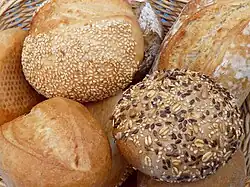
There is a multitude of names from north to south; the number of variations is huge. It is worth going to a bakery in each area and trying out new variations. The local names are often supplemented, e.g. sesame, multigrain and rye rolls.
- Brötchen is mainly used in Lower Saxony, Mecklenburg-Western Pomerania, North Rhine-Westphalia, northern Rhineland-Palatinate, large parts of Hesse, northern Saxony-Anhalt and parts of Brandenburg. This term is also understood and, the more so, grudgingly accepted in the rest of Germany.
- In Thuringia, in southern Saxony-Anhalt and in Saxony, Brötchen and Semmel are used.
- Rundstück is used in Schleswig-Holstein, Hamburg and parts of northwestern Lower Saxony.
- Semmel is used throughout Bavaria and southern Thuringia, as well as understood in wide parts of the entire south. It is also the word that - as part of a coumpound noun - is used in the German translation of the Holy Bible for 'breadcrumbs': Semmelmehl (lit. 'roll flour').
- Weck(-en/-e/-a), or Weck(-le/-li/-la) are mainly used in Baden-Württemberg, Rhenish Hesse, South Hesse, the Palatinate, and Saarland. In Franconia, Weggla refers to a milk roll;
- The Schrippe is common mainly in Berlin and Brandenburg, but also in Hamburg, Schleswig-Holstein and Mecklenburg-Western Pomerania.
- Bömmel is the name on Hiddensee Mecklenburg-Vorpommern.
- Kipf(-l/-la/-le), Laabla, Stella/Stolle, Wegg(-la/-li) one says in Franconia
- Stüütkes hot buns in Platt, West Lower Saxony.
Local specialities
Starting from the north of Germany going south you will find a tremendous variety of food and each region sticks to its origins. The coastal regions are fond of seafood and famous dishes include "Finkenwerder Scholle".
In the region of Cologne you will find Sauerbraten, which is a roast marinated in vinegar. Traditionally made from the tough meat of the horses who worked their lives pulling river barges up the Rhine, these days the dish is usually made from beef.
Labskaus (although strictly speaking not a German invention) is a dish from the north and the opinions about this dish are divided, some love it, others hate it. It is a mash of potato, beetroot juice and cured meat decorated with rollmops and/or young herring and/or a fried egg and/or sour cucumber and/or beetroot slices on top. The north is also famous for its lamb dishes, the best type of lamb probably being "Rudenlamm" (lamb from Ruden, a small island in the Baltic Sea; only a few restaurants in Mecklenburg-Western Pomerania serve this), the second best type being "Salzwiesenlamm" (salt meadow lamb). The Lüneburger Heide (Lueneburg Heath) is famous not only for its heath but also for its Heidschnucken, a special breed of sheep. Be aware that a lot of restaurants import their lamb from New Zealand though because it is cheaper. Crabs and mussels are also quite common along the German coasts, especially in North Frisia.
A specialty of Hamburg is "Aalsuppe" which – despite the name (in this case "Aal" means "everything", not "eel") – originally contained almost everything – except eel (today many restaurants include eel within this soup, because the name confused tourists). At the coast there's a variety of fish dishes. Beware: if a restaurant offers "Edelfischplatte" or any dish of similar name, the fish may not be fresh and even (this is quite ironic) of poor quality. Therefore, it is strongly recommended that, for eating fish, you visit specialised (or quality) restaurants only. A fast-food style restaurant chain serving standardised quality fish and other seafood at low prices all over Germany is "Nordsee", though you will rarely find authentic specialties there.
Pfälzer Saumagen: Long a well-known dish in Palatinate, but difficult to find outside of this area. Literally this is pig stomach filled with a mash of potato and meat, cooked for 2–3 hours and then cut into thick slices. It is often served with sauerkraut. It gained some notoriety as Helmut Kohl was fond of serving it to official state guests such as Gorbachev and Reagan when he was Chancellor.
Swabia is famous for Spätzle (a kind of noodle, often served with cheese as Kässpätzle) and "Maultaschen" (noodles stuffed with spinach and mince meat, but lots of variations, even veggie ones, exist).
In Bavaria this may be Schweinshaxe mit Knödeln (pork's leg with knödel, a form of potato dumplings), "Leberkäs/Fleischkäse mit Kartoffelsalat" (a type of meat pie and potato salad), "Nürnberger Bratwurst" (probably the smallest sausage in Germany), Weißwurst (white sausages) and "Obatzda" (a spicy mix of several milk products).
The south is also famous for its nice tarts such as the "Schwarzwälder Kirschtorte" (tart with lots of cream and spirits made from cherries).
A delicacy in Saxony is Eierschecke, a cake made of eggs and cream similar to cheese cake.
A specialty of the East is "Soljanka" (originally from Ukraine, but probably the most common dish in the GDR), a sour soup containing vegetables and usually some kind of meat or sausages.
 Pfälzer Saumagen with Sauerkraut, allegedly the favourite dish of former Chancellor Helmut Kohl
Pfälzer Saumagen with Sauerkraut, allegedly the favourite dish of former Chancellor Helmut Kohl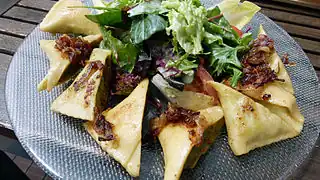 Maultaschen from Baden
Maultaschen from Baden Schwarzwälder Kirschtorte, cherry cake from the Black Forest region
Schwarzwälder Kirschtorte, cherry cake from the Black Forest region
Seasonal specialities

White asparagus (Spargel) floods the restaurants from April to June all over Germany, especially in and around Baden-Baden and the small town of Schwetzingen ("The Asparagus Capital"), near Heidelberg, in an area north and north-east of Hannover ("Lower Saxony's Asparagus Route"), as well as in the area southwest of Berlin, especially in the town of Beelitz and along the Lower Rhine ("Walbecker Spargel"). Franconia, particularly the Knoblauchsland around Nuremberg also produces quite good asparagus. Many vegetables can be found all year round and are often imported from far away, whereas asparagus can be found for only 2 months and is best enjoyed fresh after harvest, it stays nice for a couple of hours or until the next day. The asparagus is treated very carefully and it is harvested before it is ever exposed to daylight, so that it remains white. When exposed to daylight it changes its colour to green and might taste bitter. Therefore, white asparagus is considered to be better by most Germans. Especially in areas with a Spargel growing tradition the devotion to this white vegetable can seem near-religious and even rural mom and pop restaurants will have a page or more of Spargel recipes in addition to their normal menu.
The standard asparagus meal is the asparagus stalks, hollandaise sauce, boiled potatoes, and some form of meat. The most common meat is ham, preferably smoked; however, you will also find it teamed with schnitzel (fried breaded pork), turkey, beef, or whatever is available in the kitchen.
White asparagus soup is one of the hundreds of different recipes that can be found with white asparagus. Often it is made with cream and contains some of the thinner asparagus pieces.

Another example of a seasonal specialty is kale (Grünkohl). You can find that mainly in Lower Saxony, particularly the southern and south-western parts such as the "Emsland" or around the "Wiehengebirge" and the "Teutoburger Wald", but also everywhere else there and in the eastern parts of North-Rhine-Westphalia. It is usually served with a boiled rough sort of sausage (called "Pinkel") and roasted potatoes. If you are travelling in Lower-Saxony in fall, you should get it in every "Gasthaus".
Lebkuchen are some of Germany's many nice Christmas biscuits and gingerbread. The best known are produced in and around Nuremberg.
Stollen is a kind of cake eaten during the Advent season and yuletide. Although native to Dresden, Saxony; it can be found everywhere in Germany.
Around St. Martin's day and Christmas, roasted geese ("Martinsgans" / "Weihnachtsgans") are quite common in German restaurants, accompanied by "Rotkraut" (red cabbage, in southern Germany it is often called Blaukraut) and "Knödeln" (potato dumplings), preferably served as set menu, with the liver, accompanied by some kind of salad, as starter, goose soup, and a dessert.
Snacks
- Fischbrötchen (fish sandwiches) are ubiquitous in the north of the republic and on the coasts, as Bismarck, matjes, salmon, fish burette, smoked fish sandwiches and others. Prices are between €2 and €3, depending on the version, and over the decades they have made their way into the rest of the country.
- There are Bratwürste in all of Germany with a staggering number of sausage variations. They are particularly popular in Franconia and Thuringia. Outside of Franconia and maybe Bavaria, you're likely to get Thuringian Bratwursts.
- Currywurst is a sausage with a sauce based on ketchup or tomato paste and curry powder. The usual side dishes are bread rolls or French fries. Herta Heuwer was considered the inventor in 1949 in Berlin-Charlottenburg. The sausage now exists nationwide, but Berlin and the Ruhr area are considered strongholds.
- Döner kebab was invented by Turkish immigrants. There shouldn't be a pedestrian zone in Germany where you can't get a döner kebab. The usual variant is flat bread quartered and cut open, filled with lamb or veal (and up to 60% minced meat) from the spit (turkish döner = turn), supplemented with a salad garnish of leaf salad, tomatoes, cucumbers, onions, white and red cabbage, sheep cheese and peppers and sauces with mayonnaise and yogurt. Döner kebab with rice and salad or with French fries is offered as a plate dish.
- There is no sandwich tradition in Germany, but for decades belegte Brötchen have been sold in bakeries, butchers and kiosks, which are serious competitors for fast food chains. They are more varied and lovingly filled and you can often taste the regional specialities. Besides bakeries and fast food stalls, butcher's shops also offer them, often with sausages, meat or Leberkäse.
Street food
The number of snack carts is increasing in Germany, and meals deviating from the usual snacks are finding more and more followers. At foodtrucksdeutschland.de you can find an overview of what is culinary on Germany's streets. The offered courts are creative and the quality of the meals is high. Several times a year the Franconian Food Truck Roundup is held in Nuremberg, a meeting of food trucks from all over Germany and Austria. The food trucks are usually open Monday to Friday at different locations in the greater Nuremberg area and on weekends often at events, details of the locations can be found on the respective homepage. There is also an app for food trucks throughout Germany.
Sweets
- Rote Grütze (red fruit jelly) is a dessert served with lightly whipped cream or vanilla sauce. Various red fruits are bound with the addition of sugar and some fruit juice with cornflour.
- Spaghettieis was invented in Mannheim in 1969. Vanilla ice cream is pressed through a spaetzle press, creating the spaghetti-like shape, over which comes strawberry sauce mimicking tomato sauce and grated white chocolate mimicking grated cheese. There have since been other ice cream creations that attempt to look like savoury dishes but Spaghettieis remains by far the most popular.
- Schwarzwälder Kirschtorte (Black Forest gateau) is a classic German cake known all over the world. It usually consists of chocolate sponge cake bases flavoured with kirsch, cherry filling, cream, cherries and chocolate shavings as decoration.
- The pastry that goes by many names, including Krapfen, Berliner and Pfannkuchen are yeast dough balls, which are baked floating in fat and then filled. The fillings - and indeed the commonly used name - vary greatly from region to region. In the north and the Rhineland red strawberry or cherry jam is preferred, in Bavaria apricot, plum or raspberry jam, in Swabia, Baden and Franconia rose hip marrow (known locally as "Hiffenmark" but virtually unknown elsewhere), in East Germany plum jam. Newer creations also use vanilla cream, nougat, cream or egg liqueur as filling. The traditional topping is powdered sugar but with American influence different glazings in sometimes garish colours have become common. Traditionally they are eaten during carnival and in some places around New Year's Eve but at least a limited selection is available year round. A traditional Carnival "joke" is the mustard-filled doughnut, but these days (as there are fewer and fewer people who make them at home) it is increasingly rare.
- Dominosteine are a gingerbread speciality, which are available all year round, but actually belong to the Christmas pastry. The cubes consist of several layers, brown gingerbread and on top fillings like marzipan, persipan (apricot or peach kernel "marzipan") and fruit jelly and then covered with chocolate on the outside. They were developed by the Dresden chocolatier Herbert Wendler in 1936, and during the Second World War, they became popular as an emergency praline.
- Rumkugeln (also Punschkugel or Trüffel) is a round confection made of fat, sugar, nuts or almonds, chocolate and cocoa rolled in chocolate sprinkles. As the name suggests, they are mostly made with rum, but only with rum aroma.
- Marzipan is a sweet made of almonds and sugar that is traditionally eaten for Christmas, and is a speciality of the city of Lübeck.
Flat cakes

- A classic of German cuisine is the Bienenstich (literally "bee's sting"). A yeast dough is rolled out thinly on a tray and spread with a vanilla, cream or fat cream. A mixture of fat, sugar and almonds is placed on top, which caramelises during baking and forms a firm lid.
- With the Streuselkuchen (crumble cake), the covering of crumbles is the decisive factor. The crumbs that cover the filling are made from sugar, fat and flour. The base of the cake is a thin yeast dough, followed by the filling and the sprinkles. There are no limits to the fillings, from apple and plum to rhubarb and poppy seeds - anything is possible.
Ice cream
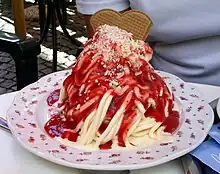
Italian Gelato is held in high regard in Germany. As Germany has a lot of Italian immigrants and their descendants (and Germany has had a love affair with Italian cuisine since at least the 1950s), every self-respecting village of any size will have at least one Italian Eisdiele, often combined with a pizzeria. While classic flavours like vanilla, chocolate or strawberry are common in Germany, too, there is the above-mentioned Spaghettieis and an ice-cream flavour that can only be described as "blue", variously called Schlumpf (smurf) Babyblau, Bubblegum, or various other names, but invariably of a hard-to-describe rather artificial flavour – a favorite with the kids. Since about the turn of the millennium, ice cream shops have been experimenting more and more with rather unusual flavours, and you'll usually have at least a dozen to choose from.
Chocolate
Chocolate in Germany is generally of high quality and quite dark unless you ask for Kinder Schokolade ("children's chocolate", their name for milk chocolate), whether you are getting it in solid or liquid hot chocolate form.
Beverages
There is so much to say about German beer and wine, that Wikivoyage has a separate article on these important elements of German cuisine.
Mixed drinks
- Sweet Schorle is made by mixing wine with lemonade. Sour Schorle is made by mixing wine with mineral water. One of Germany's most popular non-alcoholic drinks is Apfelschorle (apple juice with sparkling water), which is usually mixed with slightly more juice than water.
- Beer mixed with lemonade is called Radler ("the cyclist") in the south and Alsterwasser in the north. In East Germany (particularly Berlin/Brandenburg), there is often a variation in which red raspberry soda is used instead of lemonade. This mixed drink is known as Potsdamer.
- Berliner Weiße, slightly sour wheat beer is often drunk mit Schuss, i.e. with some sweet syrup, often raspberry or woodruff. These can be bought pre-mixed in many supermarkets.
- Spezi is a mixed drink of cola and orange lemonade. The original has actual orange juice in it, but many restaurants will just mix orange soda and coke if no pre-mixed Spezi is on hand.
Soft drinks and water
Germany does not have a tradition of sugary fizzy drinks but the usual US-inspired beverages can be had in most places. The generic term for a sugary carbonated drink is Limo, short for Limonade and the usual flavours are gelb ("yellow" or orange-flavour) and weiß ("white", actually transparent and lemon-flavoured). To some extent, sugary soft drinks are seen as being for children in restaurants, with adults usually ordering sparkling or still mineral water, an alcoholic drink, juice or Schorle. Apfelschorle can be bought premixed in supermarkets but restaurants will accommodate all Schorle wishes by mixing juice with sparkling water if they have the required juice. Domestic soft drink innovations are Bionade, a fermented non-alcoholic beverage with organic ingredients and Mate (pronounced with two syllables: mah-tay), a sweetened and carbonated derivation of mate-tea which gives a certain caffeine boost. Both those drinks were especially popular with the urban boheme before finding a more widespread audience.
When ordering water, it will be assumed that you mean sparkling water unless you explicitly order stilles Wasser ("still water"). The cost of sparkling and still (non-bubbly) water is usually the same. The non-carbonated version may contain various salty minerals; if it's important to have plain water, a request for "Etwas wie Evian?" ("Something like Evian?") will give the servers the right idea. If you need plain old tap water, you can ask for Leitungswasser ("pipe water").
Caffeinated beverages
With the exception of East Frisia which is particular to tea more than most of the rest of Germany, coffee is the caffeinated beverage of choice. Germans have a high opinion of the Italian and French coffee traditions and thus coffee is often sold under Italian and French names and even a German proud of domestic engineering will appreciate an Italian espresso machine. Coffee chains like Starbucks and domestic clones of it abound in all towns of any size and attract the usual urban boheme, but Kaffee und Kuchen (coffee and cake) is a well-honoured tradition for a lazy afternoon or an informal gathering, albeit with more of a focus on the cake and pastry than the coffee.
Going out
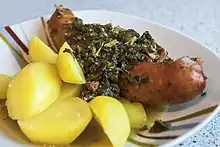
- Unlike in other countries, in Germany, with very few exceptions, you can freely choose your table in the restaurant. In some American-style diners and in the upscale gastronomy, it is part of the flair to be assigned a seat. It is, however, possible to ask staff for a free table when entering a restaurant in order to shorten your own search.
- Especially in traditional restaurants in rural areas, it is still customary to share tables with strangers. Those coming to the table would ask those already there whether sharing the table is an issue.
- If there is a sign on the table with the inscription Reserviert (reserved), you should not sit at this table, as it is already reserved for other guests. In many restaurants, there is still a time on the reservation, whereupon one can estimate whether the time is still sufficient around something to eat or drink before the other guests come.
- Usually Germans eat with a knife, fork and spoon, with exceptions only at snack bars, East Asian restaurants, in fast food restaurants and with poultry dishes. If you want to indicate to the staff that you have finished eating and can be cleared, place the knife and fork at an angle on the plate, approximately in the positions of 11 or 5 o'clock.
- It is not unusual in Germany if everyone at a table has to pay individually and the waiter has to issue several bills. When the bill comes, staff might ask "zusammen oder getrennt?" (i.e. [are you paying] together or separately?).
- It has become common to have larger leftovers packed for home use. Just ask the staff, who usually offer a friendly solution.
- There is no fixed rule for the tip (Trinkgeld) in Germany, but it should be something between 5% and 10% if you were satisfied with food and service. If you were not satisfied, there is also no problem in giving nothing. Frequently the amount is rounded up, e.g. from €9.20 to €10 or from €47.80 to €50.
- According to the law, menus (Speisekarte) must either be laid out on tables or presented to the guest before the order is placed, or must be clearly legible. The prices quoted already include service charges, taxes and other surcharges; separate surcharges, e.g. for music, or for the place setting, are not permitted. At least one menu with a meaningful selection of food and drink prices must be clearly displayed next to the entrance.
- In Germany, it is mandatory to name additives in food. There are often small numbers on the menus behind the dishes and at the bottom of the page, or on the last page of the menu you can find the footnote with the additives. The list includes colourings, preservatives, flavour enhancers, etc. Few additives indicate that everything was prepared from fresh ingredients; many additives can be an indication of convenience, that the cooked dish was only warmed up.
- As in the rest of the EU, potential allergens are by law clearly indicated with letters beside the dish name if necessary. Bread can also be served gluten free at several establishments upon request.
- The calibration mark (Eichstrich) is a marking on beverage containers (limo glasses, beer glasses, schnapps glasses, wine glasses and wine carafes in commercial dispensing). The volume must be stated as a numerical value with a unit of measurement, so the guest can check how much was poured.
- Service staff are very often college or even high school students working as a side-gig and as such they can be overwhelmed on busy days, but they try their best. As pay is comparable to other entry-level jobs requiring little experience (and the tax system is not built on the assumption of tips) tips are not a necessary part of the salary and - in part due to Germans disliking "kiss-ass behaviour" - service staff will be a bit more blunt and less flirty and friendly than you might be used to.
- In some bars on busy nights or with large parties, it may be common that each order is to be paid upon delivery. In that case, it is common to round up the tip for easier handling the change (and to ensure smoother service for the next round). It is also not uncommon to have a Bierdeckel (a cardboard coaster) where the service staff notes the amount consumed, either with simple lines or with the price of the goods. A common Deckel might contain three lines (indicating three standard-sized beers) and the amount €4.50 indicating something costing that amount and will be paid in one go and individually.
- Takeout and delivery have become vastly more common as a result of the Covid-19 Pandemic. These days almost all restaurants that allow dine-in service will also have takeout service at least one day of the week. If they don't have a sign advertising it, just ask.
Biergarten
In traditional beer gardens in Bavaria, you can bring your own food if you buy their drinks. Most places will offer simple meals. Some Biergärten are also known as Bierkeller (literally beer cellar), especially in Franconia. Historically, Bierkeller originate from the need to store beer in a cool place prior to artificial refrigeration. Thus underground structures were dug and soon beer would be sold directly out of storage in the summer months, giving rise to the Bierkeller tradition as we know it today. Many are set in quite beautiful natural surroundings, but probably the best known ensemble of Bierkeller can be found in Erlangen where they gave rise to the Bergkirchweih, one of the biggest beer festivals in the area. They were dug through a mountain just out of town and gave the city an edge in beer storage and consequently higher production capabilities, which led to beer from Erlangen becoming a household name once the railway connection enabled export. The invention of artificial cooling ended that advantage, however. The cellars still exist and besides their role in Bergkirchweih one of them operates as a normal Keller (as it is often shortened to) year round.
As the name implies, a beer garden is in a garden. It may be entirely outdoors, or you may be able to choose between an indoor (almost always non-smoking) area and an outdoor area. They range in size from small, cozy corners to some of the largest eating establishments in the world, capable of seating thousands. Munich's Oktoberfest, which happens at the end of September each year, creates some of the most famous temporary beer gardens in the world.
Restaurant chains
In addition to the international fast-food chains that everyone knows, there are also restaurant chains that have their origins and their main focus in Germany. That said, chains don't dominate the food scene and there are a lot of independently-owned restaurants or small "chains" with a handful of locations, especially in the higher price and quality rungs.
- Block House operates more than 42 steak restaurants. The brand Jim Block is a burger chain with the special feature that the burgers are prepared in front of the guest.
- Cafe Del Sol is a restaurant chain with a bar offering a Mediterranean ambience. The restaurant offers international cuisine as well as pizza and pasta with a manageable menu, a second emphasis is a bar with cocktails.
- Cafe Extrablatt is a franchise often found in the centers of smaller cities. They offer anything from breakfast in the morning to cocktails in the evening.
- Gosch specialises in seafood such as fried and cooked fish, lobster, oysters and others. There are over 12 businesses on Sylt and 26 businesses spread across Germany as well as restaurants on the cruise ships Mein Schiff
- Kochlöffel Gastronomy chain with grilled chicken, curry sausage, various burgers, salads and soft drinks.
- Maredo has over 50 restaurants and is known for high quality steaks.
- Nordsee is a fast-food restaurant chain focusing on fish and seafood with several hundred locations, from the pedestrian zone to the motorway service area. It's often your best bet for decent if not outstanding fish dishes when far from the coast.
- Peter Pane another chain of burgers and associated dishes
- Sausalitos is a restaurant chain that offers Californian-Mexican cuisine food and drinks.
- L’Osteria is a restaurant chain with Italian cuisine. The pizza has a diameter of 45 cm, there are also antipasti, pasta, salads, and desserts.
- In Vapiano branches, Italian fast food is prepared in front of customers. The chain attaches great importance to the style of its restaurants, designed by the South Tyrolean architect Matteo Thun. There are antipasti, pasta, pizzas, salads and desserts. The pasta dishes combine pre-portioned fresh noodles, 180 g, of various shapes with various sauces. A lot of their outlets shut down in the late 2010s and early 2020s but they're still a pretty common sight.
- Wienerwald is mainly represented in larger cities with chicken products, the grill chicken is famous. The chain used to be one of Germany's most successful domestic fast food outlets, but tastes have changed and now they have become a much rarer sight.
- Hans Im Glück - Burgergrill is a quick restaurant chain in contrast to the American chains, with high quality products, freshly prepared, vegetarian burgers, alcoholic beverages.
- Tchibo a chain that started selling only coffee but branched out into various consumer goods. You can also have a sit down coffee with surprisingly edible cake there.
Highway rest stops
Autobahn rest stops in Germany have a reputation for being shabby, unpleasant and overpriced places that take advantage of a captive market. Most of them are owned by Tank&Rast, who run their own restaurants under the brand "Serways", as well as hosting franchised brands. Road signs will inform you of the next rest stop and what's available in terms of food and drink facilities. If the usual suspects of global fast food are available, they'll announce their presence via a tall illuminated signpost with their logo.
Culinary calendar
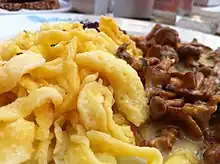
Culinary delights are often seasonal. Fruit and vegetables are tastier when they are harvested ripe. Meat and fish are also subject to seasonal influences. At any time of the year, festivities are celebrated that focus on enjoyment in general or on certain foods in particular. There are also drinking and eating habits in the course of the year, which have arisen from religious traditions such as Lent.
January
- Die Internationale Grüne Woche, the world's largest fair for food, agriculture and horticulture, takes place at the beginning of the year in Berlin.
- Carp and shellfish seasons in months with "r" (using the English names)
- Kale is a typical winter vegetable from northern Germany; in the south, it is not popular. The traditional kale meals take place from November to Maundy Thursday (which falls somewhere between late March and mid-April). In many parts Lower Saxony and Schleswig-Holstein it is a real treat to go on a kale ride with clubs, companies, and other groups in the autumn and winter months. A typical dish is Kohl mit Pinkel, a smoked Grützwurst.
February
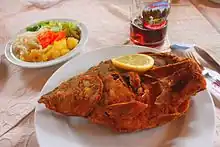
- Carp and shellfish seasons in months with an "r"
- The smelt fish (Stint) spawn in the Elbe for a few weeks from the end of February to April. The fish are gutted and the head removed, salted and then turned into rye flour, fried. And eaten with warm bacon and potato salad. The speciality is offered on the Elbe from the mouth up via Hamburg to about Lüneburg.
- Kale is a typical winter vegetable from northern Germany, though in the south, it is largely unknown. The traditional kale meals take place from November to Maundy Thursday.
March
- Carp and shellfish seasons in months with an "r"
- The smelt fish (Stint) spawn in the Elbe for a few weeks from the end of February to April. The fish are gutted and the head removed, salted and then turned into rye flour, fried. And eaten with warm bacon and potato salad. The speciality is offered on the Elbe from the mouth up via Hamburg to about Lüneburg.
- The "hop asparagus weeks" in the Hallertau take place from mid-March to early April. The tender root shoots of the hop plant are harvested by hand and offered in the local gastronomy as a speciality. They can only be used as long as the shoots grow under the ground protected from light. The growth is strongly dependent on the weather, therefore the harvest time, of about three weeks, can only be determined shortly before. When the plant shoots grow out of the soil, the harvest is over.
- In March and April, on the Mecklenburg Baltic Sea Coast, e.g. in Wismar, Warnemünde on Usedom and Rügen there are Heringswochen'
- From March to mid-May is wild garlic season; this forest-growing herb smells intensely of garlic and animates many dishes.
April
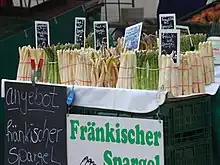
- The "hop asparagus weeks" in the Hallertau take place from mid-March to early April. The tender root shoots of the hop plant are harvested by hand and offered in the local gastronomy as a speciality. They can only be used as long as the shoots grow under the ground protected from light. The growth is strongly dependent on the weather, therefore the harvest time, of about three weeks, can only be determined shortly before. When the plant shoots grow out of the soil, the harvest is over.
- Carp and shellfish seasons in months with an "r"
- From March to mid-May is wild garlic season; this forest-growing herb smells intensely of garlic and animates many dishes.
- The smelt fish (Stint) spawn in the Elbe for a few weeks from the end of February to April. The fish are gutted and the head removed, salted and then turned into rye flour, fried. And eaten with warm bacon and potato salad. The speciality is offered on the Elbe from the mouth up via Hamburg to about Lüneburg.
- The asparagus season starts from the beginning to mid-April, depending on the soil temperature
- The Day of Beer is celebrated on April 23rd, because on this day in 1516 the German Purity Law was proclaimed. In many places there are many beer events (Deutscher Brauer Bund).
- At the end of April and in May there is the Maischolle (may plaice), it is caught in the North Atlantic or in the North Sea, measures approximately 35 to 45 cm and has particularly tender meat. It is often served Finkenwerder style with bacon.
May
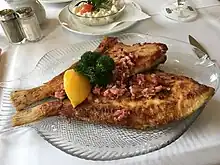
- Asparagus season
- At the end of April and in May there is the Maischolle (May plaice) season
- From March to mid-May is wild garlic season; this forest-growing herb smells intensely of garlic and livens up many dishes.
- The Weindorf is a culinary wine festival at the market place in Würzburg. It lasts 10 days from the last Friday in May.
June
- The asparagus season ends on St John's Day, 24 June.
- From mid-June, Matjes is served, garnished with potatoes in the skin or black bread and fresh green beans.
July
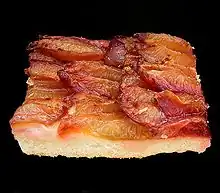
- July/August is chanterelle (Pfifferlinge) season with many different chanterelle mushroom dishes.
- The world's largest Labskaus meal takes place on a Saturday mid/end of July in Wilhelmshaven. Thousands of portions of Labskaus are sold, the record was reached in 2005 with over 10,000 portions.
- July is the beginning of cherry and plum season. Look for cherries and plum cakes in the bakeries. In the south, Zwetschgendatschi is a seasonal cake that is topped with a solid layer of plums.
August
- July/August is chanterelle season with many different chanterelle dishes.
- The Internationales Berliner Bierfestival takes place on a weekend at the beginning of August, 2.2 km between Strausberger Platz and Frankfurter Tor, where around 340 breweries from 86 countries presented 2400 types of beer and well over 800,000 visitors from all over the world are expected.
- A weekend at the end of August in Coburg is Dumpling Market. Everything revolves around the Coburg dumpling, also called the Coburger Rutscher. There are various roasts to the dumplings, such as sour and pork roast and roulades with the appropriate sauces
- August/September is mushroom season, porcini mushrooms and other wild mushrooms enrich the menu.
September
- The new carp and shellfish seasons begin, the first month with an "r."
- August/September is mushroom season, porcini mushrooms and other wild mushrooms enrich the menu.
- Federweißer, Bremser or Sturm, i.e. fermented wine. The serving is limited to a few weeks in autumn.
October
- Federweißer', Bremser or Sturm, whatever the fermenting wine in Germany is called. The serving is limited to a few weeks in autumn.
- In autumn there are many game dishes' on the menus.
- Carp - and mussel season in months with an "r."
- The Day of open distilleries and breweries is held every year in the Franconian Switzerland on the third Sunday in October
- In Nuremberg the trade fair Consumenta provides a wide range of national and international specialities and the chance to get a taste of some of them.
November
- There's a lot of game on the menu in the fall.
- Around St. Martin's Day on 11 November, many inns offer goose dishes as traditional goose dishes.
- Carp and shellfish seasons in months with an "r"
- Kale is a typical winter vegetable from northern Germany; in the south it is not as common. The traditional kale meals take place from November to Maundy Thursday. In many parts Lower Saxony and Schleswig-Holstein it is a real cult to go on a cabbage ride with clubs, companies and other groups in the autumn and winter months. A typical dish is Kohl mit Pinkel, a smoked Grützwurst.
- In November the open weekend mummegenussmeile' takes place in the city centre of Braunschweig. Gastronomes offer creations around the Mumme (a viscous malt extract) and at a market you can buy Mumme products.
December
- The pre-Christmas season is the time of Christmas markets with mulled wine and gingerbread
- Kale is a typical winter vegetable from northern Germany, in the south it is largely unknown. The traditional kale meals take place from November to Maundy Thursday. In many parts Lower Saxony and Schleswig-Holstein it is a real treat to go on a cabbage trip with clubs, companies and other groups in the autumn and winter months. A typical dish is Kale with Pinkel, a smoked Grützwurst.
- Carp and shellfish seasons in months with an "r"